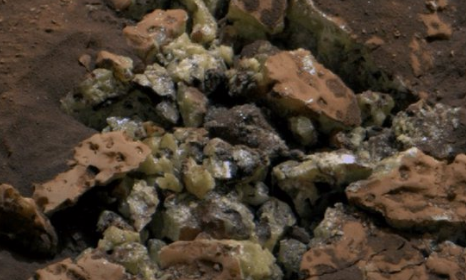Scientists were astounded on May 30 when NASA’s Curiosity Mars rover revealed something unprecedented on the Red Planet: yellow sulfur crystals. This discovery occurred as the rover drove over a rock, causing it to crack open. Since October 2023, Curiosity has been exploring a sulfate-rich region of Mars, which contains salts formed as water evaporates. However, this is the first time pure elemental sulfur has been found, distinguishing it from previously detected sulfur-based minerals.
Elemental sulfur, which is odorless unlike its sulfur compound counterparts, forms under specific conditions not typically associated with the history of this Martian location. The rock sample revealed a significant amount of sulfur, indicating the presence of more such rocks in the area. Ashwin Vasavada, Curiosity’s project scientist, likened finding these sulfur stones to discovering an oasis in a desert, highlighting the unexpected nature of this find.
Think of the game ‘What’s in the Box?’ — except the box is a Martian rock, and the surprise is pure sulfur crystals!
NASA’s Curiosity rover found this unexpected treasure in Gale Crater: a rock with elemental sulfur, not the usual mixed minerals.https://t.co/OoqRn8FaF4 pic.twitter.com/sml44kkOZ0
— The Weather Channel India (@weatherindia) July 19, 2024
Curiosity made this discovery in Gediz Vallis channel, a region with significant geological interest. This channel, which winds down part of the 3-mile-tall Mount Sharp, has been a key target for study due to its potential to reveal Mars’ ancient climatic and hydrologic history. The channel was likely shaped by ancient water flows and debris, leaving behind boulders and sediment mounds. Recent clues suggest that both ancient floods and landslides contributed to the landscape’s formation.
Curiosity’s findings in Gediz Vallis include rounded rocks indicating water transport and angular rocks likely deposited by dry avalanches. Additionally, the presence of “halo” shapes in some rocks points to chemical reactions from water seepage, further emphasizing the region’s dynamic geological past.
Curiosity rover cuts open rock on Mars, spilling out an unexpected secret
READ: https://t.co/IBlAuNFQBMhttps://t.co/IBlAuNFQBM
— WION (@WIONews) July 19, 2024
In June, Curiosity drilled its 41st rock sample from a nearby large rock named “Mammoth Lakes.” The rover’s instruments will analyze the powdered rock to determine its composition. This ongoing exploration continues to provide valuable insights into Mars’ history and potential for past life.
Key Points:
- Curiosity Mars rover discovered pure yellow sulfur crystals on Mars, a first for the Red Planet.
- The finding was made in a sulfate-rich region, highlighting the difference between elemental sulfur and sulfur-based minerals.
- Gediz Vallis channel, the site of the discovery, shows evidence of ancient water flows and landslides.
- Curiosity’s exploration revealed rounded rocks from water transport and angular rocks from dry avalanches.
- Curiosity drilled its 41st rock sample in June for further analysis to understand Mars’ geological history.
Fallon Jacobson – Reprinted with permission of Whatfinger News



